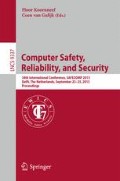Abstract
The AUTOSAR End-to-End library is used to protect data. On the producer side a counter and checksum are added, such that on the consumer side it can be detected whether there was a communication failure. For optimal bus utilisation, it is a common solution that a producer publishes data that is read by many consumers. If the data also needs to be protected, this results in an End-to-Many-Ends solution.
In this paper, we analyse the impact of an End-to-Many-Ends solution on the safety guarantees of the AUTOSAR End-to-End Protection. In particular with focus on the problem that arises when the consumers read the messages with a periodicity that differs from the producer. It turns out that this common situation severely reduces the safety guarantees these standard components offer. In this report we analyze these reductions on different architectures.
Access this chapter
Tax calculation will be finalised at checkout
Purchases are for personal use only
Notes
- 1.
The standard for Profile 1 makes it impossible to distinguish dropping 14 messages from dropping none.
- 2.
Minimal 1 fail free cycle between two bursts, otherwise it is the same burst, but of a longer period.
- 3.
All the results and scripts to reproduce them are available at https://es.fbk.eu/people/tonetta/tests/safecomp15.
- 4.
The presented method is applicable to any concrete case, we present a case that closely resembles our understanding of car software.
- 5.
A very fast car can accelerate 0.65 m in 50 ms. Reducing speed can go much faster, but at that moment, most safety functions do not need the speed data any more.
References
ISO 26262: Road vehicles Functional safety (2011)
AUTOSAR: Software architecture specification www.autosar.org
AUTOSAR. In: Specification of SW-C End-to-End Communication ProtectionLibrary. AUTOSAR consortium (2008–2013)
Arts, T., Dorigatti, M., Tonetta, S.: Making implicit safety requirements explicit. In: Bondavalli, A., Di Giandomenico, F. (eds.) SAFECOMP 2014. LNCS, vol. 8666, pp. 81–92. Springer, Heidelberg (2014)
Armstrong, J.: A history of Erlang. In: HOPL, pp. 1–26 (2007)
Arts, T., Hughes, J., Johansson, J., Wiger, U.: Testing telecoms software with Quviq QuickCheck. In: ACM SIGPLAN Workshop on Erlang (2006)
Arts, T., Hughes, J., Norell, U., Svensson, H.: Testing AUTOSAR software with QuickCheck. In: Proceedings of TAIC Part 2015 (2015)
Cimatti, A., Clarke, E., Giunchiglia, E., Giunchiglia, F., Pistore, M., Roveri, M., Sebastiani, R., Tacchella, A.: NuSMV 2: an opensource tool for symbolic model checking. In: Brinksma, E., Larsen, K.G. (eds.) CAV 2002. LNCS, vol. 2404, pp. 359–364. Springer, Heidelberg (2002)
Cavada, R., Cimatti, A., Dorigatti, M., Griggio, A., Mariotti, A., Micheli, A., Mover, S., Roveri, M., Tonetta, S.: The nuXmv symbolic model checker. In: Biere, A., Bloem, R. (eds.) CAV 2014. LNCS, vol. 8559, pp. 334–342. Springer, Heidelberg (2014)
Cimatti, A., Dorigatti, M., Tonetta, S.: OCRA: a tool for checking the refinement of temporal contracts. In: ASE, pp. 702–705 (2013)
McMillan, K.L.: Symbolic Model Checking. Kluwer Academic, Dordrecht (1993)
Pnueli, A.: The temporal logic of programs. In: FOCS, pp. 46–57 (1977)
Broy, M., Huber, F., Schätz, B.: AutoFocus - Ein Werkzeugprototyp zur Entwicklung eingebetteter Systeme. Inform. Forsch. Entwickl. 14(3), 121–134 (1999)
Forest, T., Jochim, M.: On the fault detection capabilities of AUTOSAR’s end-to-end communication protection CRC’s. In: SAE (2011)
Cimatti, A., Griggio, A., Mover, S., Tonetta, S.: Parameter synthesis with IC3. In: FMCAD, pp. 165–168 (2013)
Acknowledgements
We thank Martin Skoglund for useful input on realistic values for the safety case parameters. The research leading to these results has received funding from the ARTEMIS JU for the nSafeCer project under grant agreement n\(^o\) 295373 and from National funding.
Author information
Authors and Affiliations
Corresponding author
Editor information
Editors and Affiliations
Rights and permissions
Copyright information
© 2015 Springer International Publishing Switzerland
About this paper
Cite this paper
Arts, T., Tonetta, S. (2015). Safely Using the AUTOSAR End-to-End Protection Library. In: Koornneef, F., van Gulijk, C. (eds) Computer Safety, Reliability, and Security. SAFECOMP 2014. Lecture Notes in Computer Science(), vol 9337. Springer, Cham. https://doi.org/10.1007/978-3-319-24255-2_7
Download citation
DOI: https://doi.org/10.1007/978-3-319-24255-2_7
Published:
Publisher Name: Springer, Cham
Print ISBN: 978-3-319-24254-5
Online ISBN: 978-3-319-24255-2
eBook Packages: Computer ScienceComputer Science (R0)

